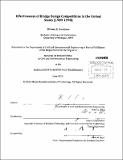| dc.contributor.advisor | John A. Ochsendorf. | en_US |
| dc.contributor.author | Goodman, Brooke K. (Brooke Kowal) | en_US |
| dc.contributor.other | Massachusetts Institute of Technology. Dept. of Civil and Environmental Engineering. | en_US |
| dc.coverage.spatial | n-us--- | en_US |
| dc.date.accessioned | 2012-10-10T15:45:04Z | |
| dc.date.available | 2012-10-10T15:45:04Z | |
| dc.date.copyright | 2012 | en_US |
| dc.date.issued | 2012 | en_US |
| dc.identifier.uri | http://hdl.handle.net/1721.1/73785 | |
| dc.description | Thesis (M. Eng.)--Massachusetts Institute of Technology, Dept. of Civil and Environmental Engineering, 2012. | en_US |
| dc.description | Cataloged from PDF version of thesis. | en_US |
| dc.description | Includes bibliographical references (p. 150-152). | en_US |
| dc.description.abstract | Surrounded by a constantly changing built environment, the design community is charged with the responsibility of constantly reacting and adapting, creating and innovating, and competing to make the best products. Design procurement methods serve as a vehicle for design professionals to enact change within their built environment and this thesis seeks to address and analyze one such method, bridge design competitions. Unlike Europe, the United States has held few bridge design competitions over the last 20 years, and this thesis focuses on three as case studies: the U.S. Naval Academy Bridge design competition (1989), the San Francisco-Oakland Bay Bridge design process (1997), and the Woodrow Wilson Bridge design competition (1998). This study uses published literature, newspaper and journal articles, design competition literature, and personal interviews with key players in the bridge design community in the United States and Europe. Thorough histories and personal accounts were compiled for each case study, which included both facts and personal opinion from competition organizers and participants. Advantages and disadvantages of bridge design competitions are discussed, as well as recommendations for the future goals and ambitions of design in the United States. Discussion and conclusions address current design procurement methodologies while posing commentary on the future of bridge design. Bridge design in the United States must rise to the challenge and rival the best design communities around the world. We must break away from lowest cost designs and move toward an environment that fosters and encourages innovation, creativity, and professional debate. | en_US |
| dc.description.statementofresponsibility | by Brooke K. Goodman. | en_US |
| dc.format.extent | 152 p. | en_US |
| dc.language.iso | eng | en_US |
| dc.publisher | Massachusetts Institute of Technology | en_US |
| dc.rights | M.I.T. theses are protected by
copyright. They may be viewed from this source for any purpose, but
reproduction or distribution in any format is prohibited without written
permission. See provided URL for inquiries about permission. | en_US |
| dc.rights.uri | http://dspace.mit.edu/handle/1721.1/7582 | en_US |
| dc.subject | Civil and Environmental Engineering. | en_US |
| dc.title | Effectiveness of bridge design competitions in the United States (1989-1998) | en_US |
| dc.type | Thesis | en_US |
| dc.description.degree | M.Eng. | en_US |
| dc.contributor.department | Massachusetts Institute of Technology. Department of Civil and Environmental Engineering | |
| dc.identifier.oclc | 810203536 | en_US |
